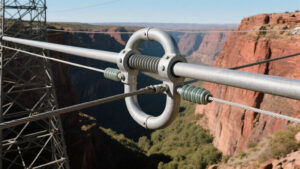Table of Contents
ToggleI. Core Definition: The Connecting Core of Transmission Lines
The power transmission clevis (known as “U-shaped hanger” in Chinese) is a critical fitting in transmission lines that connects insulator strings to towers or conductors. This specialized U-shaped connector uses pins or bolts to achieve rigid connections, undertaking the important mission of transmitting mechanical loads and maintaining electrical clearance in overhead lines.
In power industry standards, the clevis is classified as “hanger hardware”. Its main function is to reliably connect suspension or tension insulator strings to tower crossarms while ensuring line flexibility and adjustability.
 II. Structural Features: Precision Engineering for Power Applications
II. Structural Features: Precision Engineering for Power Applications
Power specialty clevis features special structural design:
U-shaped body: Made of high-strength forged steel or malleable iron, 30-50% thicker than industrial clevis
Reinforced pinholes: Increased wall thickness with rounded edges to avoid stress concentration
Corrosion protection: Hot-dip galvanized coating ≥86μm, passing 3000-hour salt spray test
Special pins: Anti-rotation design with cotter pin holes to prevent disengagement
III. Core Functions: Three Missions of Power Connection
- Mechanical load transfer:
- Withstands comprehensive mechanical stresses including conductor weight, wind loads, ice loads
- In UHV lines, a single clevis must withstand over 10 tons of continuous tension
- Electrical insulation assurance:
- Maintains sufficient air insulation distance
- Prevents corona discharge (with smooth surface treatment)
- Operational maintenance convenience:
- Provides flexible connection angle adjustment
Facilitates insulator replacement during line maintenance
 IV. Types and Applications: Adapting to Various Voltage Levels
IV. Types and Applications: Adapting to Various Voltage Levels
Standard U-hangers:
For 110-220kV lines
Material: Malleable iron KT-35
Nominal load: 70-100kN
Reinforced hangers:
For 330-500kV lines
Material: High-strength forged steel Q345
Nominal load: 150-200kN
UHV specialty hangers:
For 750-1000kV lines
Material: Alloy steel 35CrMo
Nominal load: 300-400kN
Tension string hangers:
For line terminals, angle towers
With adjustment holes for length fine-tuning
Failure load exceeding 500kN
V. Technical Standards: Strict Power Industry Specifications
Power clevis must meet the following standards:
Mechanical performance: Failure load ≥4 times maximum working load
Electrical performance: No visible corona (at 1.1 times maximum working voltage)
Corrosion resistance: Uniform hot-dip galvanizing, no missed areas or peeling
Dimensional accuracy: Hole diameter tolerance ±0.2mm, hole distance tolerance ±0.5mm
Main standards:
DL/T 757-2009 “Tension Clamps”
GB/T 2315-2008 “Nominal Failure Load Series for Power Fittings”
ANSI C119.4-2004 “Overhead Line Hardware Standards”
VI. Installation & Maintenance: Key Aspects of Power Safety
Installation requirements:
Use torque wrenches with design-specified values
Cotter pins must be symmetrically bent at 60-90 degrees
Pin ends should protrude 2-5 threads
Maintenance points:
Regular inspection of zinc coating integrity (every 2 years)
Check pins for loosening or corrosion
Measure residual mechanical strength (every 10 years)
Danger alerts:
Zinc coating loss >10%: Replace immediately
Cracks or deformation found: Replace immediately after power outage
Pin wear exceeding 10% of diameter: Replace immediately

 II. Structural Features: Precision Engineering for Power Applications
II. Structural Features: Precision Engineering for Power Applications IV. Types and Applications: Adapting to Various Voltage Levels
IV. Types and Applications: Adapting to Various Voltage Levels


